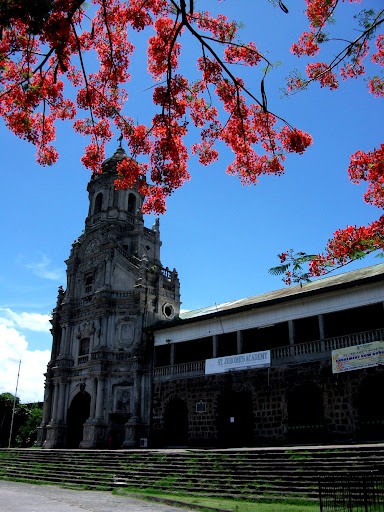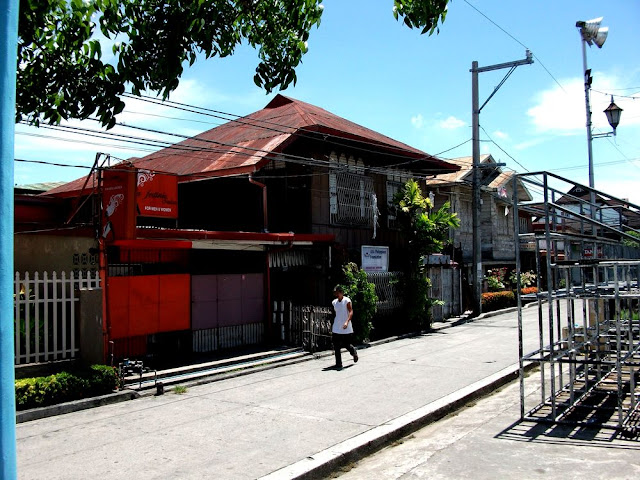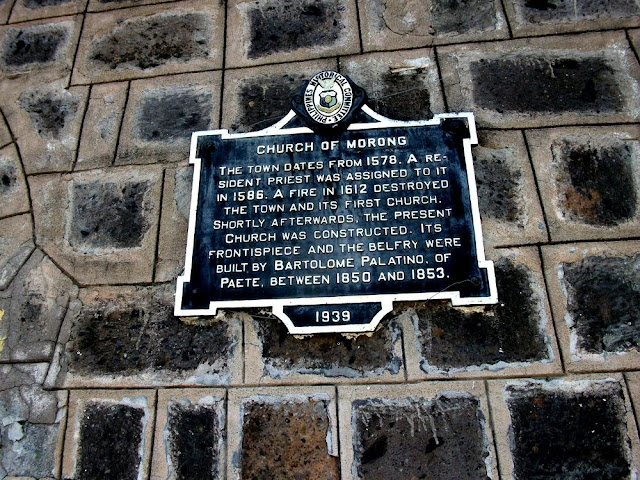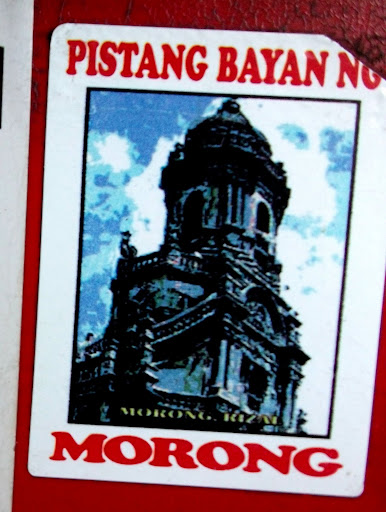Morong Moro
Its surprising how provinicial some towns are even if they’re just a few kilometers away from the capital. Morong in Rizal is one such town.
I came to see the town to visit its famed San Geronimo church but ended up wandering around for awhile.
The entire province was once called the province of Morong. They renamed the province after Rizal (as if he needs more publicity).
It baffles me why they changed the name?
Morong refers to its former inhabitants, the Moros, said to have lived in the peninsula’s mountainous parts.
Could this be the reason why?
Were they (Americans and Filipino leaders in the early 1900’s) uncomfortable with such a name? Or were they just massively promoting Rizal as an idol for the Filipinos so they’ll follow his peaceful ways versus the revolutionaries, whom at that time was still popular in the countryside?
If it had not been changed, there would have been the issue of what to call the people of the province since they’re not Moro.
They refer to themselves today as “Rizalenos”. Out of curiosity, I asked a couple of locals in the area and “Rizaleno” sounded alien to them.
But for me, old names should never be replaced because history is lost. Just as you would not rename a living person not unless you want to hide his past.
Some refute that the name came from “Moro”. But I believe there’s historical basis that it did. The Moro, historically the adversary of Catholic Spain, were dispersed when the two met in Manila.
The Moros must’ve fled to the mountains after Manila was placed under Spanish rule. Even the Moro rebels of our modern times seeks refuge in the mountains. But how they seem to have vanished is a mystery.
The Moro we see today in Manila trace their roots back to the South. They were not the Mohammedan that Legazpi drove out of Manila.
Thankfully, a town, Morong, can still remind us of this history. Not unless our bright politicians rename the quaint municipality.
There are very few extant old houses now in Morong. The plaza is where you can find some of them.
The town is unique because unlike the usual pueblo where you’ll find all historically significant buildings in the vicinity of the church. The church is perched on a hill while the plaza and the municipio can be found right across the river if you’re coming from San Geronimo.
America in Moro
Morong is one of the first towns (together with Antipolo) to be taken from the Filipinos in this parts during the Filipino American war.
More than one hundred years ago Elihu Root describes Morong’s industry: “A mountanous country, abounding in stone quarries, banks of jasperated marbles and gold beds. Much rice and sugar cane are raised.”
Usually, American observations are scouting reports of the industries present in each town.
July 4 reported Philadelpia Times: “Americans swept the Morong peninsula, wins two battle and takes the the town of Morong and Antipolo”. This begun the pacification and eventual control of the Yanqui in that beautiful peninsula.
The town produced the first Filipino casualty in WWI. A native of Morong, Tomas Mateo Claudio, studying in America he joined the US Marines to fight in Europe. He died in France and to this day is celebrated as Morong’s greatest hero. A monument of Claudio can be found in the plaza. A main street and a school is also named after him.
Old Traditions
Cultural celebrations in Morong are among the liveliest in the entire country. During Lent they parade “Santos” on their streets. It is considered having the most number of processionals icons in the province. Christmas is celebrated based on traditions that has come down through generations.
Morong’s old traditions persist even in this modern complicated times.
They speak with an Tagalog accent exceedingly rare. Possibly an accent that is still present in other parts of Provincia de Morong. How different is it with the other Tagalog provinces?
I’ve encountered many Tagalog accents and it looks like Morong’s is a bit milder, more laid back.
Yglesia de San Geronimo
The main reason for my visit is to see what many consider as the most fascinating and significant church facade in the province. A look reveals much of its history and origin.

Church and convent of San Geronimo. The flame trees were beautifully blossoming around the church yard.
On top is a dedication to its Franciscan builder. “Esta portada se construido ano 1851 y 52 siendo cura parroco el R.E.F Maximo Rico”. Local historians suspect that Chinese converts were the ones commisioned to finish the facade and the tower. This could be accurate as they have had a history of doing such works for the Church.
One of the gate lions, whom many consider proof that the bell tower was built by Chinese artisans (but usually these gate lion guards comes as gifts from Chinese converts like the ones in Sn. Agustin) had been stolen. Only the male version is now left.
Only goes to show just how cruel some of our kababayan are.
The church (and according to old people much of the town) was damaged during WWII. Much of the facade had been restored. How it was restored and by who – is not clear.
Inside the church there are still wonderful relics that has been part of the church from the beginning. Like the ukit of the Baptism of Jesus. The choir loft appears to be still the original construction.
The bell tower and facade is full of symbolism, and some say, hidden meaning. The Franciscan coat of arms, the four angels and what appears to be Mexican art can be found on it.
Recently, they’ve been gifted with relics of their patron St. Jerome. The Vatican, recognizing their devotion to the scholar saint gave them with two first class relics.
I’m sure that Morong locals are conscious of their heritage, both natural and historical, I hope they preserve what’s left for their children.
Mabuhay ang bayan ng Morong!










June 25th, 2013 at 9:31 am
LOOKING FOR MY FATHER’S FAMILY “GUILLERMO SAN LUIS VILLARIN” SADLY MY FATHER PAST AWAY IN 1997. I AM THE FIRST SON: RICHARD DAVID CARLOS VILLARIN. AM LOOKING FOR FAMILY MEMBERS IN MORONG, RIZAL! MY COUSIN BONIFASCIO VILLARIN LIVES LA, CALIF!I LIVE IN SALINAS,CALIF.
November 22nd, 2011 at 5:11 am
The facade was restored in the early 1960s by joint effort of Moronguenos and the Historical Conservation Society.
October 22nd, 2011 at 4:06 am
This is amazingly informative – a must read for every Morongueno. I will send this link along our next community announcement.
This is reminiscent of our church patio as the gathering place for my brother Amel and his friends to fly their kites from sun up to sundown. Underneath the accacia trees were boys and girls chatting, giggling and exchanging glances.
The traditions of our town are like no other – putu, tsa, bibingka, kutsinta and other delicacies are big attraction after simbang gabi, something I haven’t experienced since I left in 1962. The trip to the palengke are a real thrill – fresh fish, fruits and vegetables abound.
There are many more reflections to come from others…
October 23rd, 2011 at 1:29 am
Big thanks, Normita.
June 8th, 2011 at 4:56 pm
“But for me, old names should never be replaced because history is lost. Just as you would not rename a living person not unless you want to hide his past.”
This is the reason why I vehemently refuse to call this beautiful province RIZAL. It is still MORONG. It is the same view that I have with TAYABAS province (not QUEZON), etc.
In Calambâ, La Laguna (yes, it is LA LAGUNA and not just LAGUNA alone), the Rizal Shrine (the Rizal ancestral house) stands along Rizal Street. So that means that José Rizal lived and grew up on Rizal Street. Idiotas. Tsk tsk tsk…
Enough with name changes, por favor. We are just distorting history. Our lawmakers should know better. Don’t fix something that is not broken.